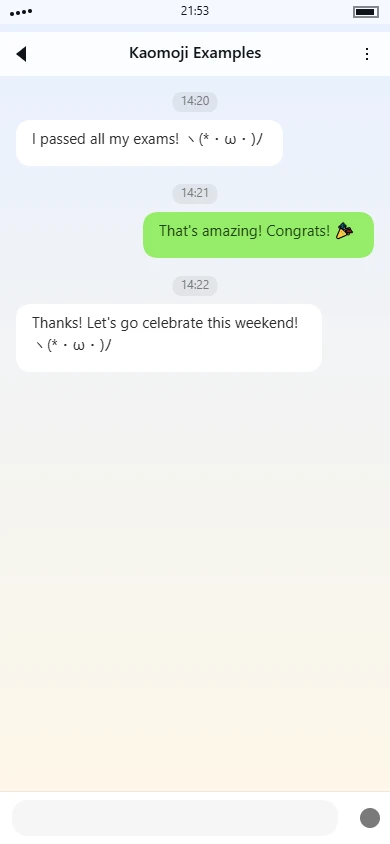( ‾́ ◡ ‾́ ) kaomoji Meaning | Usage Tips

Overview
The kaomoji
( ‾́ ◡ ‾́ )Symbol Breakdown
- Parentheses
: These characters form the basic face outline, creating a rounded head shape that frames the facial features. The parentheses provide a neutral container for the expression.( ) - Combining acute accents
: Positioned on both sides of the face, these diacritical marks serve as the eyes. The combining acute accent (U+0301) is placed above the overline character (U+203E), creating a raised eyebrow effect that suggests mild surprise or attentiveness.‾́ - Smile character
: The character U+25E1 represents a downward-curving arc, which visually forms a gentle smile. This character is slightly wider than typical mouth symbols used in kaomoji, contributing to the expression's soft quality.◡
The combination of these elements creates a face that appears both smiling and slightly alert, with the raised eyebrow marks adding a questioning or curious dimension to what would otherwise be a straightforward happy expression.
Emotion & Aesthetic Analysis
This kaomoji conveys a complex emotional state that blends contentment with mild surprise or curiosity. The gentle smile suggests satisfaction or happiness, while the raised eyebrows introduce an element of attentiveness or slight astonishment. The expression falls somewhere between a simple smile and a look of pleasant surprise, making it suitable for situations where one wants to express happy acknowledgment of unexpected information.
Compared to similar kaomoji, this version has a more subtle emotional range than exaggerated expressions like (^▽^) or (´∀`). The use of combining diacritics for the eyes creates a more refined, less cartoonish appearance than kaomoji that use standard punctuation marks or letters for facial features. The spacing between characters contributes to a balanced, composed look rather than an excited or energetic expression.
In practical usage, this kaomoji might appear in contexts where someone is pleasantly surprised by news or information, or when expressing gentle amusement at something unexpected. The expression maintains a degree of composure while still conveying positive emotion, making it appropriate for both casual and slightly more formal digital communication where extreme emotional displays might be unsuitable.
Tag categories
Use tags to quickly understand this kaomoji.
Usage guide
Usage Guide for ( ‾́ ◡ ‾́ )
This kaomoji captures a unique blend of playful innocence and subtle mischief, making it a versatile tool for digital communication. The character features a small smiling face (◡) nestled between two raised eyebrows or slight tilts (‾́), creating an expression that's simultaneously cute, slightly cheeky, and endearingly awkward. It's perfect for those moments when you want to convey happiness with a touch of playful embarrassment or when sharing something amusing without coming across as overly enthusiastic. The kaomoji works exceptionally well in casual online conversations, gaming chats, social media comments, and friendly group messages where a more nuanced emotional tone is appreciated.
Common Use Cases
- When sharing a small personal achievement that's more amusing than impressive
- Reacting to a friend's silly joke or lighthearted story in a group chat
- Expressing gentle amusement at someone's minor mistake or clumsy moment
- Accompanying a confession of something slightly embarrassing but harmless
- Responding to cute animal photos or wholesome content online
- Indicating you're teasing someone in a friendly, non-malicious way
- Showing you found something unexpectedly funny in a conversation
- Reacting to gaming moments where luck played a funny role
- When you want to acknowledge something sweet without being overly sentimental
- Expressing that you're secretly pleased about something
- Responding to food pictures that look particularly delicious
- Showing amusement at your own forgetfulness or minor errors
Example Conversations
-
Friend sharing a cooking fail: "I tried to make pancakes and somehow ended up with one giant pancake stuck to the ceiling" "Haha, only you could manage that ( ‾́ ◡ ‾́ )"
-
Gaming context: "I just spent 30 minutes looking for my sword in Minecraft only to realize I was holding it the whole time" "Classic gamer moment ( ‾́ ◡ ‾́ ) we've all been there"
-
Social media interaction: "Just saw a dog wearing tiny sunglasses and trying to look cool" "That's the content I needed today ( ‾́ ◡ ‾́ )"
-
Work chat with close colleagues: "I finally figured out that Excel formula after watching 5 tutorials" "The struggle was real but you made it ( ‾́ ◡ ‾́ )"
-
Sharing personal news: "I accidentally bought two of the same book online because I forgot I already ordered it" "Well, now you have a backup copy! ( ‾́ ◡ ‾́ )"
-
Reacting to memes: "This meme describes my entire personality" "It's scarily accurate, isn't it? ( ‾́ ◡ ‾́ )"
Important Notes
- Avoid using this kaomoji in formal emails, professional correspondence, or serious discussions where a more straightforward response is expected
- The expression carries a slightly mischievous undertone, so be mindful when using it with people who might misinterpret playful teasing
- In some contexts, it could be perceived as patronizing if used when someone is genuinely struggling with something important
- The kaomoji works best in established relationships where the playful dynamic is already understood
- Different platforms may render the characters slightly differently, so test how it looks if consistency matters
- While universally understandable in casual online spaces, the specific nuance might be lost on those less familiar with kaomoji culture
This kaomoji thrives in spaces where digital communication has developed its own subtle emotional vocabulary. It's particularly popular in gaming communities, Discord servers, and among friend groups who appreciate the art of nuanced online expression without resorting to standard emoji.
Usage examples
Real conversation samples that feature this kaomoji.

Example 1

Example 2
Related kaomoji
You might also enjoy these kaomoji.